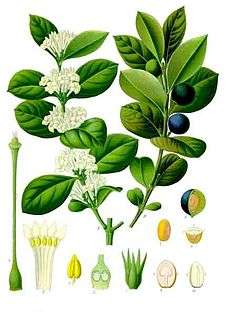Acokanthera schimperi
| Acokanthera schimperi | |
|---|---|
 | |
| Acokanthera schimperi[1] | |
| Scientific classification | |
| Kingdom: | Plantae |
| (unranked): | Angiosperms |
| (unranked): | Eudicots |
| (unranked): | Asterids |
| Order: | Gentianales |
| Family: | Apocynaceae |
| Genus: | Acokanthera |
| Species: | A. schimperi |
| Binomial name | |
| Acokanthera schimperi (A.DC.) Schweinf. | |
| Synonyms[2] | |
| |
Acokanthera schimperi, belonging to the family Apocynaceae, is a small tree native to eastern and central Africa as well as to Yemen.
Uses
The bark, wood and roots of Acokanthera schimperi are used as an important ingredient of arrow poison in Africa. All plant parts contain acovenoside A and ouabaïne, which are cardiotonic glycosides. Its fruit is edible, and is eaten as a famine food. When ripe they are sweet but also slightly bitter. Unripe fruits have caused accidental poisoning as they are highly toxic.[3]
The maned rat spreads the plant's poison on its fur and becomes poisonous.[4]
It is also used in traditional African medicine.[5]
Geographic distribution
Acokanthera schimperi is native to Eritrea, Ethiopia, Somalia, Kenya, Uganda, Tanzania, Rwanda and DR Congo. It is the only species in the genus that also occurs outside Africa, in southern Yemen.[6]
References
- ↑ illustration from Franz Eugen Köhler, Köhler's Medizinal-Pflanzen 1897
- ↑ "The Plant List: A Working List of All Plant Species".
- ↑ Schmelzer, G.H. & Gurib-Fakim, A. (Editors), 2008. Plant Resources of Tropical Africa 11(1). Medicinal plants 1. PROTA Foundation, Wageningen, Netherlands / Backhuys Publishers, Leiden, Netherlands / CTA, Wageningen, Netherlands. 791 pp.
- ↑ African crested rat uses poison trick to foil predators
- ↑ Gebre-Mariam, T; Neubert, R; Schmidt, P. C.; Wutzler, P; Schmidtke, M (2006). "Antiviral activities of some Ethiopian medicinal plants used for the treatment of dermatological disorders". Journal of Ethnopharmacology. 104 (1-2): 182–7. doi:10.1016/j.jep.2005.08.071. PMID 16233967.
- ↑ African Plant Database
External links
- Acokanthera schimperi information from NPGS/GRIN
- Acokanthera schimperi information from PROTA4U
- BBC News: African crested rat uses poison trick to foil predators